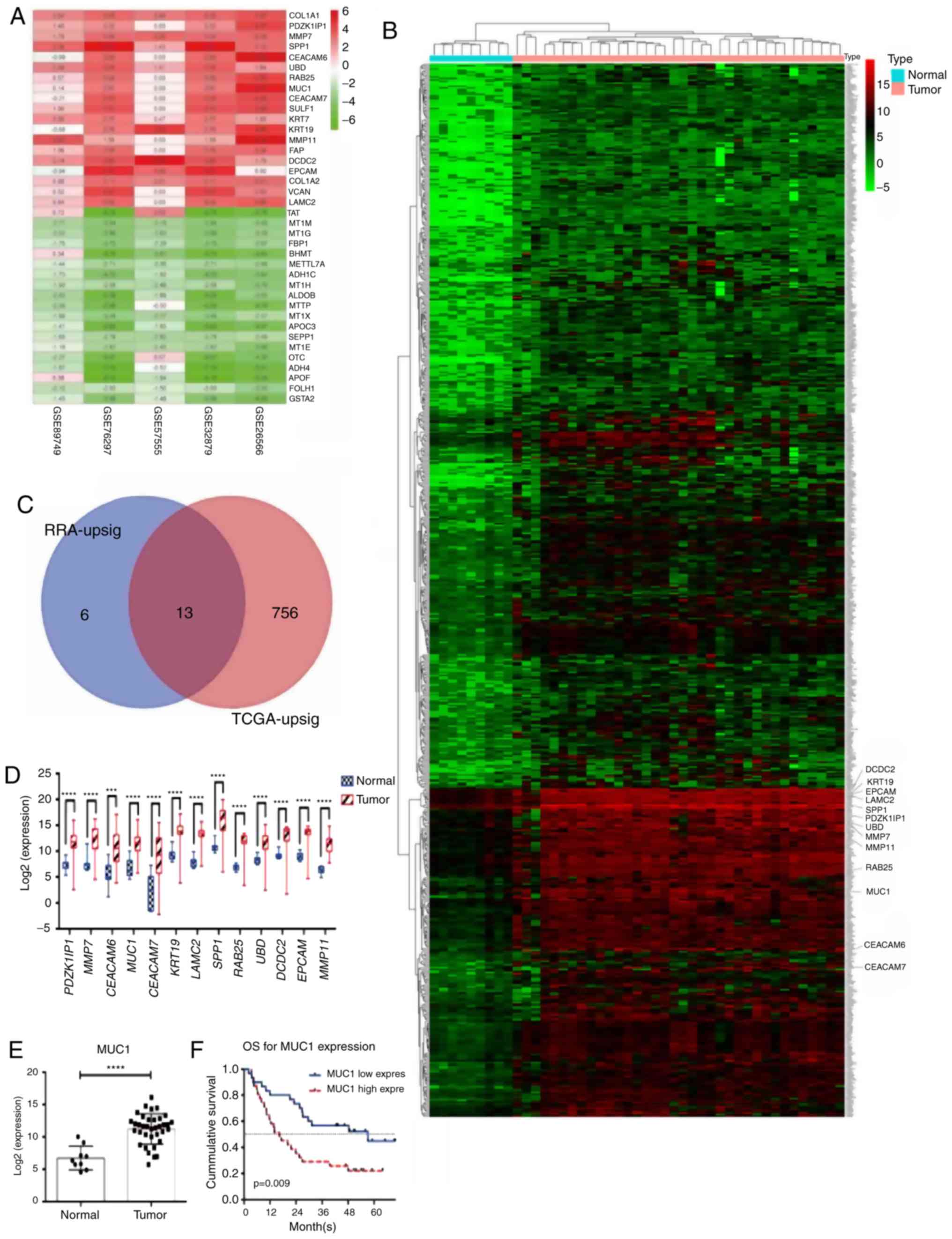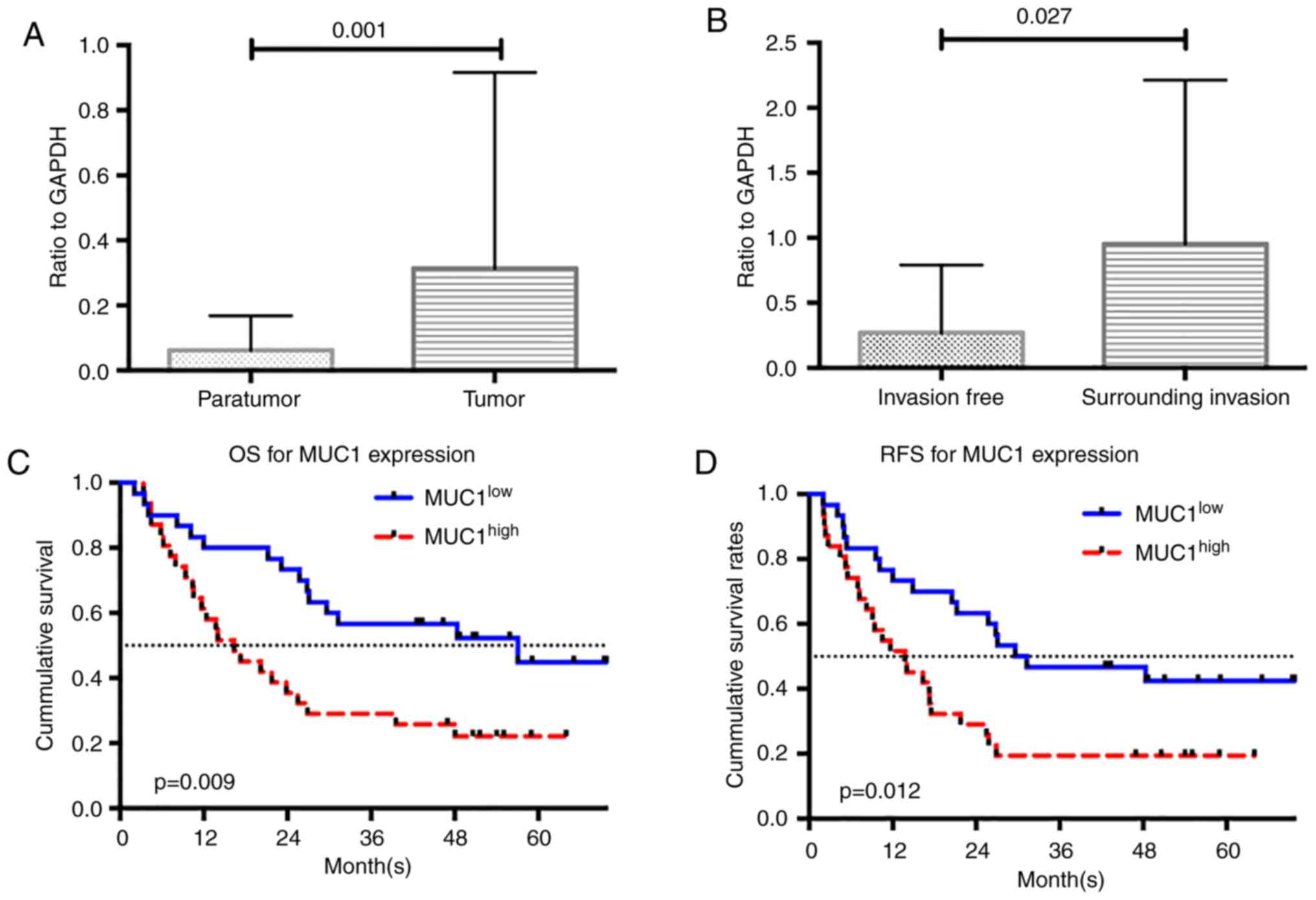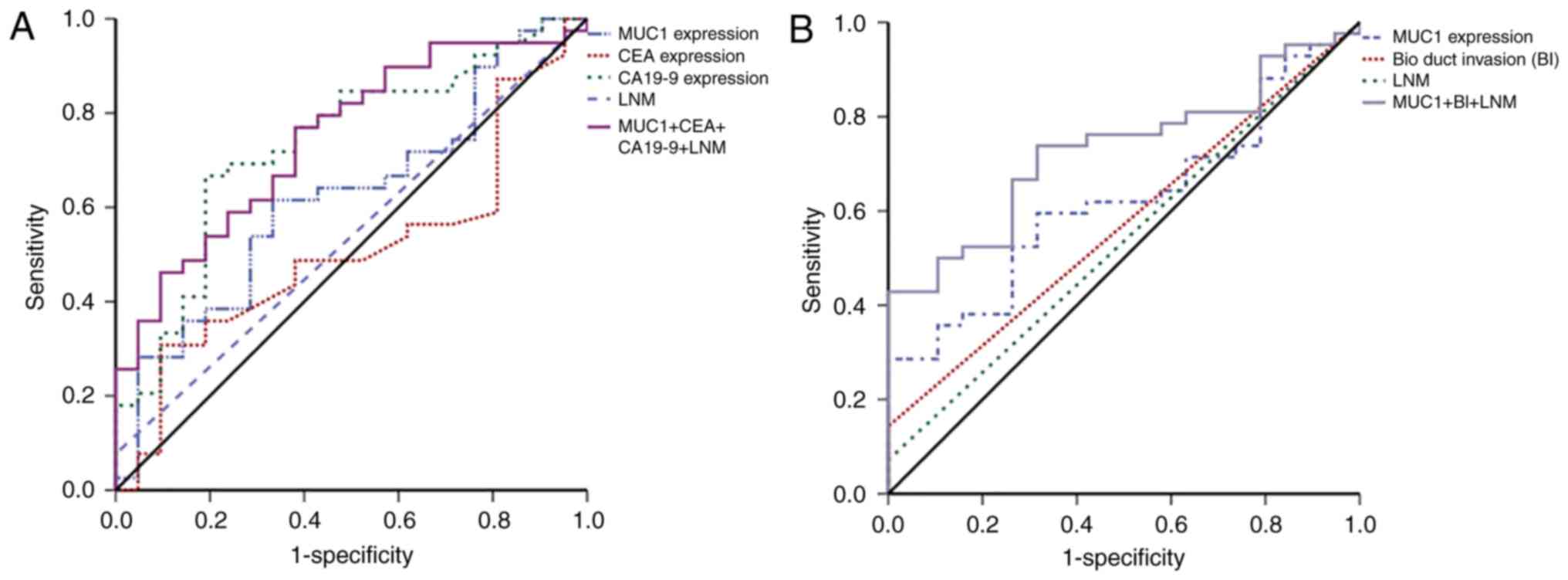|
1
|
Aljiffry M, Abdulelah A, Walsh M,
Peltekian K, Alwayn I and Molinari M: Evidence-based approach to
cholangiocarcinoma: A systematic review of the current literature.
J Am Coll Surg. 208:134–147. 2009.PubMed/NCBI View Article : Google Scholar
|
|
2
|
Buettner S, van Vugt JL, IJzermans JN and
Groot Koerkamp B: Intrahepatic cholangiocarcinoma: Current
perspectives. Onco Targets Ther. 10:1131–1142. 2017.PubMed/NCBI View Article : Google Scholar
|
|
3
|
Schlinkert RT, Nagorney DM, Van Heerden JA
and Adson MA: Intrahepatic cholangiocarcinoma: Clinical aspects,
pathology and treatment. HPB Surg. 5:95–102. 1992.PubMed/NCBI View Article : Google Scholar
|
|
4
|
Endo I, Gonen M, Yopp AC, Dalal KM, Zhou
Q, Klimstra D, D'Angelica M, DeMatteo RP, Fong Y, Schwartz L, et
al: Intrahepatic cholangiocarcinoma: Rising frequency, improved
survival, and determinants of outcome after resection. Ann Surg.
248:84–96. 2008.PubMed/NCBI View Article : Google Scholar
|
|
5
|
Dodson RM, Weiss MJ, Cosgrove D, Herman
JM, Kamel I, Anders R, Geschwind JF and Pawlik TM: Intrahepatic
cholangiocarcinoma: Management options and emerging therapies. J Am
Coll Surg. 217:736–750.e4. 2013.PubMed/NCBI View Article : Google Scholar
|
|
6
|
Shaib YH, Davila JA, McGlynn K and
El-Serag HB: Rising incidence of intrahepatic cholangiocarcinoma in
the United States: A true increase? J Hepatol. 40:472–477.
2004.PubMed/NCBI View Article : Google Scholar
|
|
7
|
Yamashita Y, Taketomi A, Morita K,
Fukuhara T, Ueda S, Sanefuji K, Iguchi T, Kayashima H, Sugimachi K
and Maehara Y: The impact of surgical treatment and poor prognostic
factors for patients with intrahepatic cholangiocarcinoma:
Retrospective analysis of 60 patients. Anticancer Res.
28:2353–2359. 2008.PubMed/NCBI
|
|
8
|
Weber SM, Ribero D, O'Reilly EM, Kokudo N,
Miyazaki M and Pawlik TM: Intrahepatic cholangiocarcinoma: Expert
consensus statement. HPB (Oxford). 17:669–680. 2015.PubMed/NCBI View Article : Google Scholar
|
|
9
|
Popat K, McQueen K and Feeley TW: The
global burden of cancer. Best Pract Res Clin Anaesthesiol.
27:399–408. 2013.PubMed/NCBI View Article : Google Scholar
|
|
10
|
Bridgewater J, Galle PR, Khan SA, Llovet
JM, Park JW, Patel T, Pawlik TM and Gores GJ: Guidelines for the
diagnosis and management of intrahepatic cholangiocarcinoma. J
Hepatol. 60:1268–1289. 2014.PubMed/NCBI View Article : Google Scholar
|
|
11
|
Rao CV, Asch AS and Yamada HY: Frequently
mutated genes/pathways and genomic instability as prevention
targets in liver cancer. Carcinogenesis. 38:2–11. 2017.PubMed/NCBI View Article : Google Scholar
|
|
12
|
Rizvi S and Gores GJ: Emerging molecular
therapeutic targets for cholangiocarcinoma. J Hepatol. 67:632–644.
2017.PubMed/NCBI View Article : Google Scholar
|
|
13
|
Rahnemai-Azar AA, Weisbrod A, Dillhoff M,
Schmidt C and Pawlik TM: Intrahepatic cholangiocarcinoma: Molecular
markers for diagnosis and prognosis. Surg Oncol. 26:125–137.
2017.PubMed/NCBI View Article : Google Scholar
|
|
14
|
Wirapati P, Sotiriou C, Kunkel S, Farmer
P, Pradervand S, Haibe-Kains B, Desmedt C, Ignatiadis M, Sengstag
T, Schütz F, et al: Meta-analysis of gene expression profiles in
breast cancer: Toward a unified understanding of breast cancer
subtyping and prognosis signatures. Breast Cancer Res.
10(R65)2008.PubMed/NCBI View
Article : Google Scholar
|
|
15
|
Võsa U, Kolde R, Vilo J, Metspalu A and
Annilo T: Comprehensive meta-analysis of microRNA expression using
a robust rank aggregation approach. Methods Mol Biol. 1182:361–373.
2014.PubMed/NCBI View Article : Google Scholar
|
|
16
|
Kolde R, Laur S, Adler P and Vilo J:
Robust rank aggregation for gene list integration and
meta-analysis. Bioinformatics. 28:573–580. 2012.PubMed/NCBI View Article : Google Scholar
|
|
17
|
Edgar R, Domrachev M and Lash AE: Gene
expression omnibus: NCBI gene expression and hybridization array
data repository. Nucleic Acids Res. 30:207–210. 2002.PubMed/NCBI View Article : Google Scholar
|
|
18
|
Smyth GK: In Bioinformatics and
Computational Biology Solutions Using R and Bioconductor
(Springer-Verlag, New York), Statistics for Biology and Health,
pp397-420, 2005.
|
|
19
|
McCarthy DJ, Chen Y and Smyth GK:
Differential expression analysis of multifactor RNA-Seq experiments
with respect to biological variation. Nucleic Acids Res.
40:4288–4297. 2012.PubMed/NCBI View Article : Google Scholar
|
|
20
|
Livak KJ and Schmittgen TD: Analysis of
relative gene expression data using real-time quantitative PCR and
the 2(-Delta Delta C(T)) method. Methods. 25:402–408.
2001.PubMed/NCBI View Article : Google Scholar
|
|
21
|
Amin MB: AJCC Cancer Staging Manual, 8th
edition.
|
|
22
|
Jusakul A, Cutcutache I, Yong CH, Lim JQ,
Huang MN, Padmanabhan N, Nellore V, Kongpetch S, Ng AWT, Ng LM, et
al: Whole-Genome and epigenomic landscapes of etiologically
distinct subtypes of cholangiocarcinoma. Cancer Discov.
7:1116–1135. 2017.PubMed/NCBI View Article : Google Scholar
|
|
23
|
Chaisaingmongkol J, Budhu A, Dang H,
Rabibhadana S, Pupacdi B, Kwon SM, Forgues M, Pomyen Y,
Bhudhisawasdi V, Lertprasertsuke N, et al: Common molecular
subtypes among Asian hepatocellular carcinoma and
cholangiocarcinoma. Cancer Cell. 32:57–70.e3. 2017.PubMed/NCBI View Article : Google Scholar
|
|
24
|
Murakami Y, Kubo S, Tamori A, Itami S,
Kawamura E, Iwaisako K, Ikeda K, Kawada N, Ochiya T and Taguchi YH:
Comprehensive analysis of transcriptome and metabolome analysis in
Intrahepatic Cholangiocarcinoma and Hepatocellular Carcinoma. Sci
Rep. 5(16294)2015.PubMed/NCBI View Article : Google Scholar
|
|
25
|
Oishi N, Kumar MR, Roessler S, Ji J,
Forgues M, Budhu A, Zhao X, Andersen JB, Ye QH, Jia HL, et al:
Transcriptomic profiling reveals hepatic stem-like gene signatures
and interplay of miR-200c and epithelial-mesenchymal transition in
intrahepatic cholangiocarcinoma. Hepatology. 56:1792–1803.
2012.PubMed/NCBI View Article : Google Scholar
|
|
26
|
Andersen JB, Spee B, Blechacz BR, Avital
I, Komuta M, Barbour A, Conner EA, Gillen MC, Roskams T, Roberts
LR, et al: Genomic and genetic characterization of
cholangiocarcinoma identifies therapeutic targets for tyrosine
kinase inhibitors. Gastroenterology. 142:1021–1031.e15.
2012.PubMed/NCBI View Article : Google Scholar
|
|
27
|
Guro H, Kim JW, Choi Y, Cho JY, Yoon YS
and Han HS: Multidisciplinary management of intrahepatic
cholangiocarcinoma: Current approaches. Surg Oncol. 26:146–152.
2017.PubMed/NCBI View Article : Google Scholar
|
|
28
|
Kaczynski J, Hansson G and Wallerstedt S:
Incidence, etiologic aspects and clinicopathologic features in
intrahepatic cholangiocellular carcinoma-a study of 51 cases from a
low-endemicity area. Acta Oncol. 37:77–83. 1998.PubMed/NCBI View Article : Google Scholar
|
|
29
|
Brayman M, Thathiah A and Carson DD: MUC1:
A multifunctional cell surface component of reproductive tissue
epithelia. Reprod Biol Endocrinol. 2(4)2004.PubMed/NCBI View Article : Google Scholar
|
|
30
|
Aplin JD, Hey NA and Li TC: MUC1 as a cell
surface and secretory component of endometrial epithelium: Reduced
levels in recurrent miscarriage. Am J Reprod Immunol. 35:261–266.
1996.PubMed/NCBI View Article : Google Scholar
|
|
31
|
Wei X, Xu H and Kufe D: Human MUC1
oncoprotein regulates p53-responsive gene transcription in the
genotoxic stress response. Cancer Cell. 7:167–178. 2005.PubMed/NCBI View Article : Google Scholar
|
|
32
|
Roy LD, Sahraei M, Subramani DB, Besmer D,
Nath S, Tinder TL, Bajaj E, Shanmugam K, Lee YY, Hwang SI, et al:
MUC1 enhances invasiveness of pancreatic cancer cells by inducing
epithelial to mesenchymal transition. Oncogene. 30:1449–1459.
2011.PubMed/NCBI View Article : Google Scholar
|
|
33
|
Higashi M, Yonezawa S, Ho JJ, Tanaka S,
Irimura T, Kim YS and Sato E: Expression of MUC1 and MUC2 mucin
antigens in intrahepatic bile duct tumors: Its relationship with a
new morphological classification of cholangiocarcinoma. Hepatology.
30:1347–1355. 1999.PubMed/NCBI View Article : Google Scholar
|
|
34
|
Park SY, Roh SJ, Kim YN, Kim SZ, Park HS,
Jang KY, Chung MJ, Kang MJ, Lee DG and Moon WS: Expression of MUC1,
MUC2, MUC5AC and MUC6 in cholangiocarcinoma: Prognostic impact.
Oncol Rep. 22:649–657. 2009.PubMed/NCBI View Article : Google Scholar
|
|
35
|
Ruys AT, Groot Koerkamp B, Wiggers JK,
Klümpen HJ, ten Kate FJ and van Gulik TM: Prognostic biomarkers in
patients with resected cholangiocarcinoma: A systematic review and
meta-analysis. Ann Surg Oncol. 21:487–500. 2014.PubMed/NCBI View Article : Google Scholar
|
|
36
|
Pillai K, Pourgholami MH, Chua TC and
Morris DL: MUC1 as a potential target in anticancer therapies. Am J
Clin Oncol. 38:108–118. 2015.PubMed/NCBI View Article : Google Scholar
|
|
37
|
Sasaki M, Nakanuma Y and Kim YS:
Characterization of apomucin expression in intrahepatic
cholangiocarcinomas and their precursor lesions: An
immunohistochemical study. Hepatology. 24:1074–1078.
1996.PubMed/NCBI View Article : Google Scholar
|
|
38
|
Lakshminarayanan V, Thompson P, Wolfert
MA, Buskas T, Bradley JM, Pathangey LB, Madsen CS, Cohen PA,
Gendler SJ and Boons GJ: Immune recognition of tumor-associated
mucin MUC1 is achieved by a fully synthetic aberrantly glycosylated
MUC1 tripartite vaccine. Proc Natl Acad Sci USA. 109:261–266.
2012.PubMed/NCBI View Article : Google Scholar
|
|
39
|
Nemunaitis J, Bedell C, Klucher K, Vo A
and Whiting S: Phase 1 dose escalation of ONT-10, a therapeutic
MUC1 vaccine, in patients with advanced cancer. J Immunother
Cancer. 1 (Suppl 1)(P240)2013.
|

















